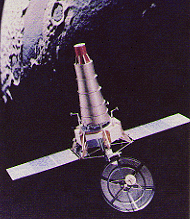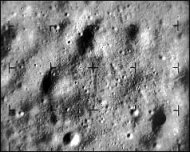Ranger
Ranger was the first of three American programs of unmanned spacecraft intended to pave the way for the Apollo lunar landings. The Ranger probes were designed to return data en route to the Moon and then crash into the lunar surface sending back images from an altitude of about 1,300 km up to the point of impact.
Rangers 1 and 2 were test missions. Rangers 3, 4, and 5 carried a capsule, containing a seismometer, which was intended to be jettisoned and then decelerated by retrorocket in order to make a rough but survivable landing. However equipment failures dogged the first six missions, some of them blamed on heat-sterilization procedures meant to destroy microbes and thus avoid contaminating the Moon. Because of these failures, NASA announced that henceforth unmanned lunar landing spacecraft, including Rangers and Surveyors, would be assembled in clean-rooms and treated with germ-killing substances to prevent contamination without damaging sensitive electronic components.
The final three flights of the series, Ranger 7, Ranger 8, and Ranger 9, were a complete success, returning a total of more than 17,000 photos with a resolution of 0.25–1.5 meters. Ranger 9 was equipped to convert its signals into a form suitable for showing on domestic television, and brought images of the Moon into ordinary homes. Millions of Americans, following live TV coverage of the final descent of Ranger 9, saw a series of pictures, starting with three flat craters – Ptolemaeus, 137 kilometers (85 miles) in diameter, Alphonsus, 80 kilomeers (50 miles) across, and Albategnius, 96 kilometers (60 miles) wide. As the spacecraft drew closer to the Moon's surface, the area photographed became large in scale and focused on the crater Alphonsus. Pictures remained sharp and clear as little as 600 meters from the surface, and then the screen suddenly went black as the probe smashed into the floor of Alphonsus. The final picture was returned when the spacecraft was just two-tenths of a second from impact. Ranger 9 completed its mission comes just 24 hours after the launch of Gemini 3.
 |
| Ranger 6
|
 |
| Image returned by Ranger 9 about three seconds before
impact
|
The Ranger program was followed by Lunar Orbiter and Surveyor.
| spacecraft | launch | lunar impact | impact site | no. of photos | mass (kg) |
| Ranger 1 | Aug 23, 1961 | - | - | - | 306 |
| Ranger 2 | Nov 18, 1961 | - | - | - | 304 |
| Ranger 3 | Jan 26, 1962 | - | - | - | 327 |
| Ranger 4 | Apr 23, 1962 | Apr 26, 1962 | far-side | - | 328 |
| Ranger 5 | Oct 18, 1962 | - | - | - | 340 |
| Ranger 6 | Jan 30, 1964 | Feb 2, 1964 | Sea of Tranquility | - | 362 |
| Ranger 7 | Jul 28, 1964 | Jul 31, 1964 | Sea of Clouds | 4,316 | 362 |
| Ranger 8 | Feb 17, 1965 | Feb 20, 1965 | Sea of Tranquility | 7,137 | 366 |
| Ranger 9 | Mar 21, 1965 | Mar 24, 1965 | Crater Alphonsus | 5,814 | 366 |


